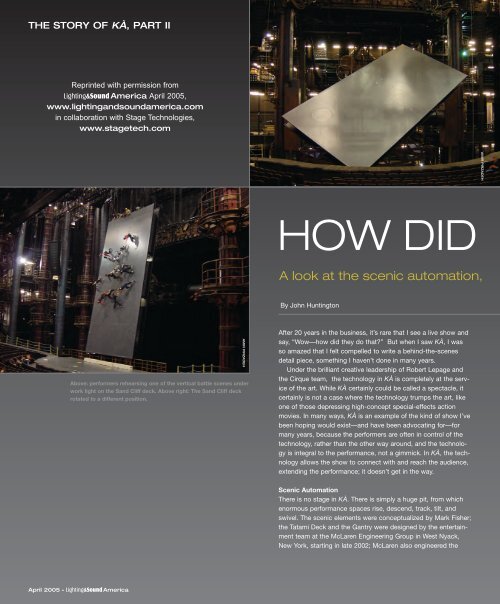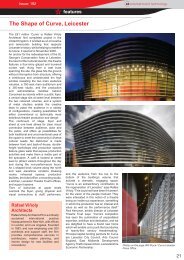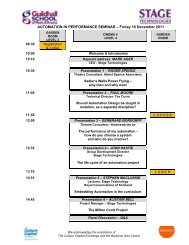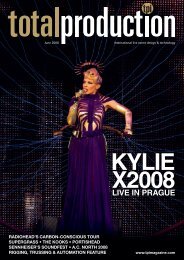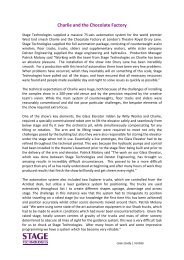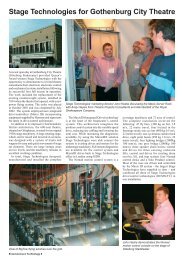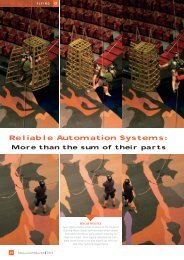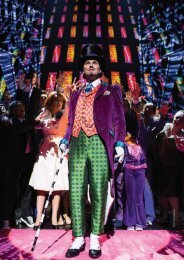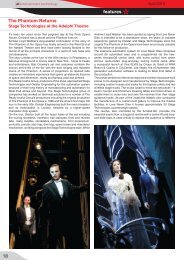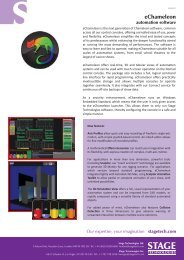The Story of KÀ part II - Stage Technologies
The Story of KÀ part II - Stage Technologies
The Story of KÀ part II - Stage Technologies
You also want an ePaper? Increase the reach of your titles
YUMPU automatically turns print PDFs into web optimized ePapers that Google loves.
KA - Part2.qxd 11/04/2005 15:09 Page 42<br />
THE STORY OF <strong>KÀ</strong>, PART <strong>II</strong><br />
Reprinted with permission from<br />
Lighting&Sound America April 2005,<br />
www.lightingandsoundamerica.com<br />
in collaboration with <strong>Stage</strong> <strong>Technologies</strong>,<br />
www.stagetech.com<br />
AMIR PIRZADEH<br />
HOW DID<br />
A look at the scenic automation,<br />
By John Huntington<br />
Above: performers rehearsing one <strong>of</strong> the vertical battle scenes under<br />
work light on the Sand Cliff deck. Above right: <strong>The</strong> Sand Cliff deck<br />
rotated to a different position.<br />
AMIR PIRZADEH<br />
After 20 years in the business, it’s rare that I see a live show and<br />
say, “Wow—how did they do that?” But when I saw <strong>KÀ</strong>, I was<br />
so amazed that I felt compelled to write a behind-the-scenes<br />
detail piece, something I haven’t done in many years.<br />
Under the brilliant creative leadership <strong>of</strong> Robert Lepage and<br />
the Cirque team, the technology in <strong>KÀ</strong> is completely at the service<br />
<strong>of</strong> the art. While <strong>KÀ</strong> certainly could be called a spectacle, it<br />
certainly is not a case where the technology trumps the art, like<br />
one <strong>of</strong> those depressing high-concept special-effects action<br />
movies. In many ways, <strong>KÀ</strong> is an example <strong>of</strong> the kind <strong>of</strong> show I’ve<br />
been hoping would exist—and have been advocating for—for<br />
many years, because the performers are <strong>of</strong>ten in control <strong>of</strong> the<br />
technology, rather than the other way around, and the technology<br />
is integral to the performance, not a gimmick. In <strong>KÀ</strong>, the technology<br />
allows the show to connect with and reach the audience,<br />
extending the performance; it doesn’t get in the way.<br />
Scenic Automation<br />
<strong>The</strong>re is no stage in <strong>KÀ</strong>. <strong>The</strong>re is simply a huge pit, from which<br />
enormous performance spaces rise, descend, track, tilt, and<br />
swivel. <strong>The</strong> scenic elements were conceptualized by Mark Fisher;<br />
the Tatami Deck and the Gantry were designed by the entertainment<br />
team at the McLaren Engineering Group in West Nyack,<br />
New York, starting in late 2002; McLaren also engineered the<br />
April 2005 • Lighting&Sound America
KA - Part2.qxd 11/04/2005 15:09 Page 43<br />
Sand Cliff deck, which was designed<br />
by Tomcat. (<strong>The</strong> other scenic pieces<br />
were done in-house at Cirque du<br />
Soleil, with the company also handling<br />
the integration <strong>of</strong> the pieces.)<br />
“Mark is a very clever man,” says<br />
McLaren Engineering president<br />
Malcolm McLaren. “He thinks motion<br />
through, and he has a very good<br />
understanding <strong>of</strong> the mechanics that<br />
it takes to drive these things. So<br />
when he gives us his thoughts on<br />
simulation s<strong>of</strong>tware. However,<br />
Nastran “was designed for mechanics<br />
and assembly lines and so forth,”<br />
explains McLaren’s Murphy Gigliotti,<br />
“so we actually had to write a cue<br />
automation front end for Nastran in<br />
Excel.”<br />
<strong>The</strong> smallest amount <strong>of</strong> power<br />
needed to make the gantry lift work<br />
as desired was “just less than a locomotive,”<br />
says McLaren. After calculating<br />
all the trade-<strong>of</strong>fs and determining<br />
THEY DO THAT?<br />
projection, and show control systems in <strong>KÀ</strong><br />
how something could be actuated, he<br />
respects the laws <strong>of</strong> physics.”<br />
<strong>The</strong> Gantry Lift<br />
<strong>The</strong> enormous 50’x25’ Sand Cliff<br />
Deck is actuated by the Gantry Lift,<br />
the largest and most incredible element<br />
<strong>of</strong> the scenic automation system—a<br />
mechanism you’d be more<br />
likely to see in an aluminum smelting<br />
plant than a theatre. <strong>The</strong> Gantry Lift<br />
mechanism can rotate the Sand Cliff<br />
Deck 360° at 2RPM (which is 12° per<br />
second) tilt it from flat up 100°<br />
(beyond vertical), and track the whole<br />
thing up and down vertically nearly<br />
70’ at 2’ per second. Determining the<br />
maximum speeds <strong>of</strong> the Gantry Lift<br />
mechanism was a critical <strong>part</strong> <strong>of</strong> the<br />
design process, since a faster move<br />
meant more horsepower was needed.<br />
To make these horsepower calculations,<br />
McLaren made extensive use <strong>of</strong><br />
sophisticated MSC Nastran design<br />
the maximum move velocities, the<br />
resulting <strong>KÀ</strong> hydraulic power plant<br />
was designed for 1,250 HP continuous<br />
from electric pumps, and,<br />
according to McLaren, about<br />
6,000HP stored as hydraulic pressure<br />
in giant accumulators for peak usage<br />
during high-power cues. “<strong>The</strong><br />
hydraulic power plant,” explains<br />
James Tomlinson, the head <strong>of</strong><br />
automation for <strong>KÀ</strong>, “will fully pressurize<br />
the accumulators (approximately<br />
1,700 gallons) in about five minutes.<br />
<strong>The</strong> accumulator bank is reminiscent<br />
<strong>of</strong> the missile tube scene from [the<br />
1990 film] <strong>The</strong> Hunt for Red October.”<br />
<strong>The</strong> Gantry Lift mechanism itself<br />
tracks on two enormous 4’ diameter<br />
steel tubes that run from the lowest<br />
floor <strong>of</strong> the building to the ro<strong>of</strong>, made,<br />
along with the rest <strong>of</strong> the “static”<br />
steel, by Fabriweld, <strong>of</strong> Salt Lake City,<br />
Utah, a company whose primary<br />
business is roller coasters and other<br />
enormous structures. McLaren<br />
Engineering was initially told that<br />
these tubes could be connected to<br />
the massive existing structure <strong>of</strong> the<br />
MGM’s ro<strong>of</strong>, but, <strong>part</strong>way through the<br />
design process, compliance with<br />
seismic regulations resulted in a new<br />
answer <strong>of</strong> no. <strong>The</strong>refore, the team<br />
had to come up with an enormous<br />
bracing structure for the tubes, creating<br />
a sort <strong>of</strong> freestanding 75’ tall<br />
“building within the building,” according<br />
to Stephen Sywak <strong>of</strong> McLaren.<br />
Many details were considered; the<br />
enormous vertical tubes are even fitted<br />
with acoustical dampers to keep<br />
them from acting like “pipe organ<br />
tubes.”<br />
A massive 6’ diameter cross tube,<br />
called the “torque tube, connects the<br />
two ‘hammerheads,’” says Tomlinson,<br />
“which are guided by 75- and 150-ton<br />
capacity Hilman rollers traveling on<br />
steel wear plates on the columns.”<br />
<strong>The</strong> rollers, made by the Hilman company<br />
<strong>of</strong> Marlboro, New Jersey, are<br />
generally used to move massive<br />
loads, like oil rigs components, entire<br />
buildings, and bridges.<br />
Perpendicularly attached to the center<br />
<strong>of</strong> the torque tube is an arm which<br />
goes out, towards the audience, to a<br />
pivot joint called the “wrist,” which,<br />
according to Tomlinson, “includes a<br />
10’ diameter Rotek bearing typically<br />
used in tower cranes,” and connects<br />
www.lightingandsoundamerica.com • April 2005
KA - Part2.qxd 11/04/2005 15:09 Page 44<br />
THE STORY OF <strong>KÀ</strong>, PART <strong>II</strong><br />
A view into the pit at one <strong>of</strong> the safety nets.<br />
to the Sand Cliff Deck itself. <strong>The</strong><br />
moving <strong>part</strong>s <strong>of</strong> the Gantry Lift were<br />
made by Timberland Industries from<br />
Woodstock, Canada, a company<br />
whose primary business is <strong>of</strong>fshore<br />
and timber harvesting equipment,<br />
giant winches and other huge mechanisms.<br />
<strong>The</strong> whole torque tube assembly<br />
and arm gets lifted, says<br />
McLaren, “by what we understand to<br />
be the longest cylinders ever produced<br />
in North America—a 70’<br />
stroke. When they are fully extended,<br />
the cylinders are 145’ long.” <strong>The</strong><br />
cylinders are so massive that they<br />
must only ever be in tension—if put<br />
under a compressive load, they might<br />
buckle.<strong>The</strong> cylinders were made by<br />
Parker, <strong>of</strong> Cleveland, Ohio and supplied<br />
(with the rest <strong>of</strong> the hydraulic<br />
system) by Atlantic Industrial<br />
<strong>Technologies</strong>, <strong>of</strong> Islandia, New York,<br />
working in conjunction with GS-Hydro<br />
U.S. Inc., <strong>of</strong> League City, Texas. Even<br />
getting the cylinders to the site<br />
proved a challenge. “We had to get<br />
special trusses fabricated,” says<br />
McLaren’s integration project manager,<br />
Jay Reichgott, “just to support the<br />
75’ hydraulic cylinders during transit.”<br />
“No one wanted to be<br />
the one to flip the<br />
switch the first time.<br />
<strong>The</strong> system was so<br />
expensive and massive<br />
that there was no room<br />
for error.”<br />
AMIR PIRZADEH<br />
<strong>The</strong> Sand Cliff Deck<br />
<strong>The</strong> 80,000lb. Sand Cliff Deck was<br />
manufactured by Tomcat USA in<br />
Midland, Texas. Longue Vue Scenique<br />
<strong>of</strong> Montreal, according to Tomlinson,<br />
“supervised the artistic treatment <strong>of</strong><br />
the playing surface by Tomcat staff.”<br />
<strong>The</strong> deck is over 6’ thick, and,<br />
according to William Gorlin, McLaren<br />
Engineering VP, consists <strong>of</strong>, “a steel<br />
primary truss structure that bolts to<br />
the slew ring. Mounted to that steel<br />
structure is an aluminum outer structure<br />
and deck system; it’s configured<br />
so that you can have technicians<br />
inside to service all the pieces.”<br />
During one <strong>part</strong> <strong>of</strong> the show, adds<br />
Tomlinson, “an 8 x 16’ ‘refuge’ platform<br />
flies in from the grid and attaches<br />
to one end <strong>of</strong> the vertical Sand<br />
Cliff Deck, then moves with the Sand<br />
Cliff Deck as it rotates, tilts, and<br />
descends to the basement. It has a<br />
trap door for access to and from the<br />
Sand Cliff catwalk system.”<br />
In addition to lifts and other features<br />
<strong>of</strong> the deck, there are 80 pegs,<br />
each roughly 2’ long, manufactured<br />
by Microtrol <strong>of</strong> Montreal, that can<br />
shoot out at 8’ per second. At that<br />
velocity, the pegs appear to the audience<br />
in a quarter second, which is<br />
surprisingly fast since they are run by<br />
electric linear actuators. <strong>The</strong>se pegs<br />
were designed so that performers can<br />
slide, swing between, and catch them<br />
when the Sand Cliff Deck is vertical.<br />
Many performers slide more than 60’<br />
from this platform to their “deaths,”<br />
where they land on an enormous,<br />
hydraulically tensioned safety net in<br />
the pit, out <strong>of</strong> sight <strong>of</strong> the audience.<br />
Some falls are so extreme that air<br />
bags are placed on top <strong>of</strong> safety nets<br />
to break the performer’s fall.<br />
In one stunning scene, the Sand<br />
Cliff Deck is covered with “sand;”<br />
then the deck is raised before our<br />
eyes and the sand pours <strong>of</strong>f. Real<br />
sand was originally considered but<br />
abandoned, due to weight and dust<br />
issues. <strong>The</strong> team considered walnut<br />
shells and Santoprene, but eventually<br />
chose cork. <strong>The</strong> material is contained<br />
on the edges <strong>of</strong> the deck by 3” “flippers,”<br />
run by 18 electrical actuators,<br />
which are retracted when the material<br />
is dumped.<br />
<strong>The</strong> Tatami Deck<br />
<strong>The</strong> 30 x 30’, 75,000lb. Tatami deck is<br />
April 2005 • Lighting&Sound America
KA - Part2.qxd 11/04/2005 15:09 Page 45<br />
an amazing feat <strong>of</strong> engineering and<br />
construction, but it’s actually the<br />
“small” piece on the show. <strong>The</strong> deck<br />
was named, according to Tomlinson,<br />
“because the opening scene with<br />
Tatami mats was to play there,” but<br />
that scene was later moved to the<br />
Sand Cliff Deck. <strong>The</strong> Tatami deck is<br />
supported by a giant, 65’ long, twostage<br />
“drawer slide” mechanism,<br />
which is tilted at a 4° rake towards<br />
the audience from its anchorage<br />
upstage, with 45’-6” <strong>of</strong> cantilever.<br />
<strong>The</strong> Tatami deck and mechanism is<br />
actuated by 75 and 150 HP electric<br />
motors, and was built by Show-<br />
Canada in Montreal, with scenic treatment<br />
again by Longue Vue Scenique.<br />
Scenic Automation Control<br />
Controlling all this scenic automation<br />
equipment was the daunting<br />
challenge taken up by <strong>Stage</strong><br />
<strong>Technologies</strong>, which has <strong>of</strong>fices in<br />
London and Las Vegas. <strong>The</strong> company’s<br />
Nomad system for <strong>KÀ</strong> controls<br />
over 40 arbor winches; 16 high-speed<br />
winches for the performers in the battle<br />
scenes, each axis with individual<br />
radio control; five lifts controlled by<br />
26 motors; a giant bird flown over the<br />
audience, controlled via five 2,200lb<br />
winches with wings flapped by performers;<br />
the 80 pegs in the Sand Cliff<br />
deck; three small pod lifts [called<br />
“sand traps,” according to<br />
Tomlinson]; 12 winches for the forest<br />
scene; 18 hydraulic safety net winches<br />
in the pit; and 16 actuators for the<br />
Sand Cliff deck’s edges.<br />
Control is highly distributed<br />
throughout the system. “We have 17<br />
nodes in the theatre, each controlling<br />
up to 40 axes,” explains Kevin Taylor,<br />
<strong>Stage</strong> <strong>Technologies</strong>’ director <strong>of</strong> electrical<br />
engineering. “<strong>The</strong> desk sends<br />
commands to the nodes, and the<br />
nodes do the housekeeping, whilst<br />
the axes deal with actual position<br />
control. <strong>The</strong>re are the Delta Tau<br />
[hydraulic control] nodes, 12 Siemens<br />
S7_400 PLCs, and the entire safety<br />
Estop [emergency stop] system is<br />
done using a Siemens safety PLC. In<br />
addition, we have two extra processors,<br />
one for the interlock system and<br />
the other to run the 3D flying <strong>of</strong> the<br />
bird. <strong>The</strong> consoles are connected<br />
over the primary command network,<br />
which is Ethernet, and the MaxisID<br />
internally positioning drives connect<br />
to the node PLCs over Pr<strong>of</strong>iBus. A<br />
separate high-speed deterministic<br />
network is used for synchronization.<br />
<strong>The</strong> crew uses four desks during the<br />
show, with a fifth backup in the event<br />
<strong>of</strong> a failure, and, happily, we have had<br />
no desk failures to date. In addition,<br />
we provide a local backup network<br />
with a completely independent path<br />
for controlling axes via a hand held<br />
HMI in a crisis. In the worst case,<br />
during the climb scene using the<br />
pegs, we could be running 90 axes at<br />
COURTESY OF MCLAREN ENGINEERING<br />
once. <strong>The</strong> majority <strong>of</strong> the time, we are<br />
running 20-25 axes at once. In the<br />
event <strong>of</strong> a motor failure, we can continue<br />
to run the lifts right down until<br />
only two are left. <strong>The</strong> lifts are the<br />
show, so there is a huge amount <strong>of</strong><br />
redundancy there.”<br />
Hydraulic Control<br />
While the <strong>Stage</strong> <strong>Technologies</strong> system<br />
provides overall control <strong>of</strong> the<br />
scenery, the hydraulics control is handled<br />
by Tisfoon Ulterior Systems, <strong>of</strong><br />
Raleigh, North Carolina, using a Delta<br />
Tau motion-control system as a basis.<br />
“We provided Tisfoon with a spec at<br />
the beginning <strong>of</strong> the project,” explains<br />
Taylor, “to enable us to make it mimic<br />
standard axes [in the Nomad control<br />
In this work light shot, the massive Sand<br />
Cliff deck is at about mid-height, with the<br />
Tatami deck retracted upstage.<br />
www.lightingandsoundamerica.com • April 2005
KA - Part2.qxd 11/04/2005 15:09 Page 46<br />
THE STORY OF <strong>KÀ</strong>, PART <strong>II</strong><br />
McLaren's schematic view <strong>of</strong> the Gantry<br />
Crane mechanism and bracing structure.<br />
system]. <strong>The</strong> operator can instruct the<br />
axes to move to a different dead [target<br />
position] at a different speed for<br />
every cue as he so wishes.” <strong>The</strong><br />
Tisfoon system takes it from there,<br />
and also provides a local controller so<br />
that the hydraulic systems can be run<br />
independently <strong>of</strong> the Nomad. To protect<br />
the cylinders, the Tisfoon system<br />
provides “a closed loop ‘charge-up’<br />
<strong>of</strong> the rod side <strong>of</strong> the cylinder before<br />
releasing the brakes,” explains the<br />
company’s president and chief s<strong>of</strong>tware<br />
engineer Amir Pirzadeh. “This<br />
insures that the valves are operational<br />
and that there is oil in the rod side<br />
before the brakes are released. <strong>The</strong><br />
load balancing is a closed-loop system<br />
on top <strong>of</strong> the regular positioning<br />
loop. This system uses the load cell<br />
information from the four cylinders to<br />
lead or lag an upstage axis (relative to<br />
downstage) for proper load balancing.”<br />
<strong>The</strong> Tisfoon system incorporates<br />
a “VCR” feature, where all data related<br />
to the hydraulic systems is logged<br />
every 100ms continuously for 24<br />
hours; if a problem develops, precise<br />
information is later available for troubleshooting.<br />
“No one wanted to be<br />
the one to flip the switch the first<br />
time,” says Pirzadeh, only <strong>part</strong>ly in<br />
jest. “<strong>The</strong> system was so expensive<br />
and massive that there was no room<br />
for error. I was not only the developer,<br />
but became the de-facto operator, as<br />
well.”<br />
COURTESY OF MCLAREN ENGINEERING<br />
Performer Winches<br />
Some <strong>of</strong> the most incredible scenes<br />
in <strong>KÀ</strong> are the “vertical battles,” where<br />
performers appear to defy gravity<br />
while battling on the Sand Cliff Deck<br />
in an almost vertical position. In fact,<br />
they are supported on high-speed<br />
winches supplied by <strong>Stage</strong><br />
<strong>Technologies</strong>. Each <strong>of</strong> the 16 performers<br />
controls his own movement<br />
through a radio control, with the<br />
transmitter in his costume, using a<br />
handset controller. “<strong>The</strong> winches”,<br />
explains <strong>Stage</strong> <strong>Technologies</strong>’ Taylor,<br />
“are capable <strong>of</strong> running at up to 14’<br />
per second, and accelerating and<br />
decelerating in .75 seconds. <strong>The</strong><br />
radio units are a standard component<br />
supplied from Germany, meet the<br />
very highest standards, and, in the<br />
event <strong>of</strong> [interference], shut down to<br />
prevent unauthorized movement.”<br />
Malcolm McLaren, summing up<br />
the team’s experience on <strong>KÀ</strong>, says,<br />
“When the Ford Motor Company<br />
releases a new car, they design it,<br />
test it, crash it, run it around the track<br />
a few thousand times, tweak it, alter<br />
it, and value-engineer it. We have to<br />
build one prototype and it has to<br />
work, with time and budget constraints.<br />
It’s not easy, and the tricks<br />
just keep getting bigger and bigger.”<br />
Projections<br />
One <strong>of</strong> the most groundbreaking<br />
aspects <strong>of</strong> <strong>KÀ</strong> is Holger Förterer’s<br />
interactive projection design. “I<br />
attempt to express poetry, emotion,<br />
and content in the language <strong>of</strong> mathematics<br />
and algorithms,” he explains.<br />
“This is my artistic language, and the<br />
result on-stage is referred to ‘augmented<br />
reality.’ We do not use any<br />
real video footage in the imagery <strong>of</strong><br />
the production—all images are generated<br />
on-the-fly by the projection computer<br />
in real time using physical or<br />
artificial simulation. Water, stone,<br />
clouds, air are all completely synthesized<br />
by the image computer—at the<br />
46 April • April 2005 2005 • Lighting&Sound • America America
KA - Part2.qxd 11/04/2005 15:09 Page 47<br />
McLaren: “When the Ford Motor Company<br />
releases a new car, they design it, test it,<br />
crash it, run it around the track a few thousand<br />
times, tweak it, alter it, and value-engineer it.<br />
We have to build one prototype and it has<br />
to work with time and budget constraints.<br />
It’s not easy, and the tricks just keep getting<br />
bigger and bigger.”<br />
some general predictability to the<br />
performers’ motions for story and<br />
safety reasons, Förterer says, “We<br />
give the performers the freedom to<br />
improvise and follow the set wherever<br />
it moves.”<br />
Tracking the Performers<br />
<strong>The</strong> freedom to which Förterer refers<br />
is quite apparent when you see the<br />
show. In one example, a scene<br />
called “<strong>The</strong> Deep”—a giant ship full<br />
<strong>of</strong> performers is raised, and performers<br />
fall <strong>of</strong>f and “drown,” descending<br />
almost the entire stage space, followed<br />
by a trail <strong>of</strong> bubbles. Förterer is<br />
tracking the performers, creating the<br />
bubble images in real time and projecting<br />
them onto the scrim. “Here,<br />
we are using camera tracking,”<br />
explains Förterer. “We are lighting the<br />
actors with invisible infrared LED<br />
light. <strong>The</strong> IR camera acquires their<br />
movement through a scrim onto<br />
which we project the bubbles. <strong>The</strong><br />
use <strong>of</strong> infrared light is necessary to<br />
avoid feedback <strong>of</strong> the projected<br />
image into the camera and be able to<br />
light the scene brightly without the<br />
audience noticing anything. My tracker<br />
picks up movement in the scene<br />
and generates bubbles based on the<br />
size and motion <strong>of</strong> the objects causing<br />
it. This is one <strong>of</strong> the scenes where<br />
projection helps in telling the story.”<br />
McLaren's schematic view <strong>of</strong> the enormous<br />
Tatami Deck "drawer slide" mechanism.<br />
same instant they are shown—and<br />
react to the action on stage.” This is<br />
the hallmark <strong>of</strong> Förterer and his<br />
team’s work on <strong>KÀ</strong>—the performers<br />
are actually controlling the imagery<br />
that surrounds them in a fully interactive<br />
and meaningful way. While, <strong>of</strong><br />
course, there is a tight structure and<br />
COURTESY OF MCLAREN ENGINEERING<br />
Scenic Interactions<br />
In “<strong>The</strong> Climb”, “<strong>The</strong> Blizzard,” and—<br />
the most astonishing scene <strong>of</strong> the<br />
show—“<strong>The</strong> Battle,” Förterer not only<br />
tracks the performers themselves, but<br />
can sense how they are interacting<br />
with the scenery. For example, under<br />
the Taraflex performance surface <strong>of</strong><br />
the Sand Cliff Deck, are sensing tiles<br />
manufactured by Les Ateliers<br />
Numériques <strong>of</strong> Montreal, which turn<br />
the entire deck into (to overly simplify<br />
for the purposes <strong>of</strong> explanation) a<br />
giant touchscreen. Förterer uses this<br />
information to create graphical waves<br />
and other images that radiate out<br />
from where the performers’ feet contact<br />
the deck, or to create interactive<br />
falling “rocks” that they must dodge.<br />
“<strong>The</strong> system <strong>of</strong> sensors in the deck<br />
was specifically created for this show<br />
by the interface designer and inventor<br />
Philippe Jean from Montreal,”<br />
explains Förterer. “It works on a technology<br />
comparable to the musical<br />
instrument theremin, which allows<br />
musicians to control electronic<br />
instruments by moving their hands in<br />
www.lightingandsoundamerica.com • April • 2005 April 2005 • 47
KA - Part2.qxd 11/04/2005 15:09 Page 48<br />
THE STORY OF <strong>KÀ</strong>, PART <strong>II</strong><br />
Förterer: “I attempt to express poetry,<br />
emotion, and content in the language <strong>of</strong><br />
mathematics and algorithms. This is my artistic<br />
language, and the result on-stage is referred<br />
to ‘augmented reality.’”<br />
the air. <strong>The</strong> deck is literally able to<br />
‘sense’ the proximity and presence <strong>of</strong><br />
the artists to and on the surface. <strong>The</strong><br />
maximum sensor depth is approximately<br />
4”. So it makes a difference if<br />
you are very close to the surface, tiptoeing,<br />
or sliding across it at a certain<br />
distance.” JT Tomlinson, Cirque’s<br />
head <strong>of</strong> automation, adds, “<strong>The</strong> sensing<br />
tiles system detects performer<br />
locations on a 6” grid pattern all<br />
across the deck and can simultaneously<br />
report every one <strong>of</strong> those coordinates,<br />
at 60Hz, via Ethernet.”<br />
With all that imagery created in<br />
real time, Förterer then projects it<br />
onto real, physical, three-dimensional,<br />
moving scenery, and the approach<br />
is so effective that many in the audience<br />
won’t even realize they are<br />
looking at projections. To accomplish<br />
this, Förterer must track the movements<br />
<strong>of</strong> the scenery exactly. <strong>The</strong><br />
projection system “listens to positions<br />
that multicast out through the<br />
Nomad system,” explains Kevin<br />
Taylor, <strong>Stage</strong> <strong>Technologies</strong> director <strong>of</strong><br />
electrical engineering. “<strong>The</strong> positions<br />
from this system are sent every<br />
50msec, and because <strong>of</strong> the size <strong>of</strong><br />
the pieces a lot <strong>of</strong> the data is sent in<br />
1,000th or 10,000th <strong>of</strong> a degree resolution.”<br />
To cope with the latency <strong>of</strong><br />
Förterer's projections can be seen clearly<br />
in this photo, although to fully appreciate<br />
them you have to see them in motion.<br />
the various systems, and potential<br />
encoder error, Förterer says, “We<br />
actually use an adaptive physical<br />
model that predicts the position <strong>of</strong><br />
the stage into the future and smooths<br />
those values correctly to avoid both<br />
lag and jitter, so we’re always on. I<br />
was surprised myself to see this work<br />
smoothly after punching in the maths<br />
for a month, but I think we mastered<br />
something you could never pre-cue<br />
or plan, since every show will not<br />
only be slightly different on the artistic,<br />
but also on the technical side.”<br />
Projecting it All<br />
Three converged Barco Director R18<br />
DLP projectors are used to give the<br />
required brightness and project from<br />
the back <strong>of</strong> the auditorium to create<br />
a canvas across a large <strong>part</strong> <strong>of</strong> the<br />
performance area. “<strong>The</strong>oretically, we<br />
could project onto any moving surface<br />
within the show,” explains<br />
Förterer. “We are using different convergence<br />
files [which call up different<br />
projector settings] to take care <strong>of</strong> the<br />
depth ranges. We are also using<br />
dousers in the drowning scene to<br />
avoid hard edges <strong>of</strong> video black<br />
resulting <strong>of</strong> the coupling, and to be<br />
able to kill all projection in an emergency.”<br />
All projections on the main<br />
TOMAS MUSCIONICO<br />
48 April • April 2005 2005 • Lighting&Sound • Lighting&Sound America America
KA - Part2.qxd 11/04/2005 15:09 Page 49<br />
moving stage use 3D modeling, “but<br />
we use a technique [similar to] the<br />
bubbles in the drowning scene to<br />
match the position <strong>of</strong> the actors oneby-one,”says<br />
Förterer. “A two-dimensional<br />
distort[ed] image would not<br />
have hit the main stage without causing<br />
warping on the close or far<br />
edge.”<br />
Infrastructure<br />
Förterer needed a lot <strong>of</strong> computer<br />
horsepower and I/O for this project,<br />
and also had to ensure that the system<br />
can be maintained and updated<br />
over the projected 10-year run <strong>of</strong> the<br />
show. “We are using dual-processor<br />
PCs,” he explains, “to ensure fast<br />
calculations and display <strong>of</strong> all virtual<br />
simulation and imagery. We kept<br />
away from most proprietary packages.<br />
Windows-dependency was<br />
reduced to a minimum; we are using<br />
OpenGL, and we skipped using the<br />
Intel Performance Libraries, since I<br />
strived for minimum dependency on<br />
the platform or processors used. Not<br />
too many portions <strong>of</strong> the code would<br />
have to be rewritten if the [IT] market<br />
went berserk for whatever reason.”<br />
With projections so critical to the<br />
show, Förterer had to also ensure<br />
that there was sufficient redundancy<br />
in the system. “We have a backup<br />
PC for all vital systems,” he explains.<br />
“Switching to backup systems is<br />
<strong>part</strong>ly automated. On a crash <strong>of</strong> the<br />
main computer, the backup computer<br />
would automatically take over within<br />
a maximum <strong>of</strong> two seconds, causing<br />
the Barco projectors to smoothly<br />
fade into the new system’s video output.<br />
This would be much faster than<br />
the operator could diagnose the<br />
problem and react by himself.”<br />
<strong>The</strong> front end for the system is<br />
actually a lighting desk, and, says<br />
Förterer, “we are not connected to<br />
the rest <strong>of</strong> lighting, to avoid both systems<br />
going down at the same time.<br />
Luc Lafortune prepared backup lighting<br />
if projections should fail—and if a<br />
certain <strong>part</strong> <strong>of</strong> lighting should, we are<br />
still ready to go.”<br />
Show Control<br />
As a show control guy who has seen<br />
and enjoyed almost every Cirque<br />
production since 1991, it has always<br />
bothered me that some <strong>of</strong> the cue<br />
timings across and between de<strong>part</strong>ments<br />
were not as tight as they<br />
could have been. This is not the<br />
case on <strong>KÀ</strong>, and this is <strong>part</strong>ly<br />
because <strong>of</strong> the use <strong>of</strong> show control<br />
for certain aspects <strong>of</strong> the show. A<br />
widely misused and misunderstood<br />
term, show control simply means<br />
interconnecting more than one production<br />
element control system<br />
(scenery, projections, sound, etc.),<br />
and on <strong>KÀ</strong>, says Förterer, “our system<br />
is networked to quite a few systems<br />
in the theatre.” <strong>The</strong> projection<br />
system receives positional data from<br />
the scenic automation systems as<br />
detailed above, and then also communicates<br />
via Ethernet to sound.<br />
“We get data from projections,”<br />
explains sound designer Jonathan<br />
Deans, “and then convert it (via MAX<br />
MSP [s<strong>of</strong>tware]) to MIDI to trigger<br />
our effects.” In some scenes, this<br />
structure allows performers to not<br />
only generate imagery interactively,<br />
but trigger sound effects as well.<br />
Cirque has recently been implementing<br />
show control systems on its<br />
cruise ship projects. However, for the<br />
more traditional shows, <strong>KÀ</strong> is “the<br />
first attempt for two de<strong>part</strong>ments to<br />
link,” according to Deans, who has<br />
worked on many Cirque productions<br />
for more than 10 years.<br />
Rigid, time-based control is what<br />
most people think <strong>of</strong> when they think<br />
<strong>of</strong> show control, and this approach<br />
has become routine in many shows<br />
today. However, the distributed and<br />
interactive interconnection seen on<br />
<strong>KÀ</strong> and other recent projects is an<br />
even more interesting and powerful<br />
Two screen captures from the <strong>Stage</strong><br />
<strong>Technologies</strong> Nomad scenic automation<br />
system showing some <strong>of</strong> the<br />
show’s systems.<br />
way forward, and is one that I hope<br />
we will see more <strong>of</strong> in the future from<br />
Cirque and others.<br />
Everyone I know is tiring <strong>of</strong> me<br />
talking about this show, but I have to<br />
say that <strong>KÀ</strong> is now Mecca for anyone<br />
interested in the intersection <strong>of</strong><br />
art and technology for live performance.<br />
You should make the pilgrimage<br />
yourself, and it’s worth plopping<br />
down $150 for the ticket, as I did.<br />
<strong>KÀ</strong> sets a new standard in artistic<br />
use <strong>of</strong> technology, raising the bar so<br />
high I’m not sure who will have the<br />
imagination and resources to exceed<br />
it.<br />
(John Huntington is an Associate<br />
Pr<strong>of</strong>essor <strong>of</strong> Entertainment<br />
Technology at NYC College <strong>of</strong><br />
Technology, and is author <strong>of</strong> the first<br />
book on entertainment and show<br />
control: Control Systems for Live<br />
Entertainment. He can be reached<br />
through his consulting company at<br />
http://www.zircondesigns.com/.)<br />
COURTESY OF STAGE TECHNOLOGIES<br />
www.lightingandsoundamerica.com • April • 2005 April 2005 • 49


